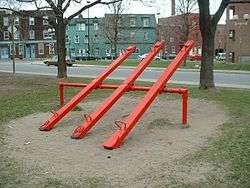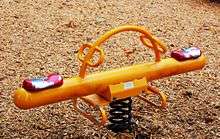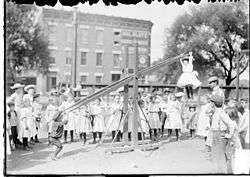Seesaw
A seesaw (also known as a teeter-totter or teeterboard) is a long, narrow board supported by a single pivot point, most commonly located at the midpoint between both ends; as one end goes up, the other goes down. These are most commonly found at parks and school playgrounds.

Varieties

The most common playground design of seesaw features a board balanced in the center. A person sits on each end, and they take turns pushing their feet against the ground to lift their side into the air. Playground seesaws usually have handles for the riders to grip as they sit facing each other. One problem with the seesaw's design is that if a child allows himself/herself to hit the ground suddenly after jumping, or exits the seesaw at the bottom, the other child may fall and be injured. For this reason, seesaws are often mounted above a soft surface such as foam, wood chips, or sand.
Seesaws also are manufactured in shapes designed to look like other things, such as airplanes, helicopters,[2] and animals.
Seesaws, and the eagerness of children to play with them, are sometimes used to aid in mechanical processes. For example, at the Gaviotas community in Colombia, a children's seesaw is connected to a water pump.[3][4]
Name origin and variations
Seesaws go by several different names around the world. Seesaw, or its variant see-saw, is a direct Anglicisation of the French ci-ça, meaning literally, this-that, seemingly attributable to the back-and-forth motion for which a seesaw is known.
The term may also be attributable to the repetitive motion of a saw. It may have its origins in a combination of "scie" – the French word for "saw" with the Anglo-Saxon term "saw". Thus "scie-saw" became "see-saw".
In most of the United States, a seesaw is also called a "teeter-totter". According to linguist Peter Trudgill, the term originates from the Nordic language word tittermatorter.[5] A "teeter-totter" may also refer to a two-person swing on a swing seat, on which two children sit facing each other and the teeter-totter swings back and forth in a pendulum motion.

Both teeter-totter (from teeter, as in to teeter on the edge) and seesaw (from the verb saw) demonstrate the linguistic process called reduplication, where a word or syllable is doubled, often with a different vowel. Reduplication is typical of words that indicate repeated activity, such as riding up and down on a seesaw.
In the southeastern New England region of the United States, it is sometimes referred to as a tilt or a tilting board.
According to Michael Drout, "There are almost no 'Teeter-' forms in Pennsylvania, and if you go to western West Virginia and down into western North Carolina there is a band of 'Ridey-Horse' that heads almost straight south. This pattern suggests a New England term that spread down the coast and a separate, Scots-Irish development in Appalachia. 'Hickey-horse' in the coastal regions of North Carolina is consistent with other linguistic and ethnic variations."[6]
References
- Benedek, George Bernard (2000). Physics, with Illustrative Examples from Medicine and Biology: Mechanics. New York: Springer. p. 379. ISBN 978-0-387-98769-9.
- Lifetime Playground, playsets and play equipment: Teeter-Totters
- "Gaviotas". Social Design Notes. 9 August 2003.
- "Engineering". Archived from the original on 7 February 2012, excerpting Weisman, Alan (1998). Gaviotas: A Village to Reinvent the World. White River Junction, Vermont: Chelsea Green Publishing.
- teeter-totter listing in TheFreeDictionary.com
- Drout, Michael D.C. (2006). A History of the English Language (Course Guide) (PDF). Recorded Books, LLC. p. 98. ISBN 978-1-4281-1730-3. Retrieved 2010-04-12.
See also
| Wikimedia Commons has media related to Seesaws. |
| Look up teeter-totter in Wiktionary, the free dictionary. |
